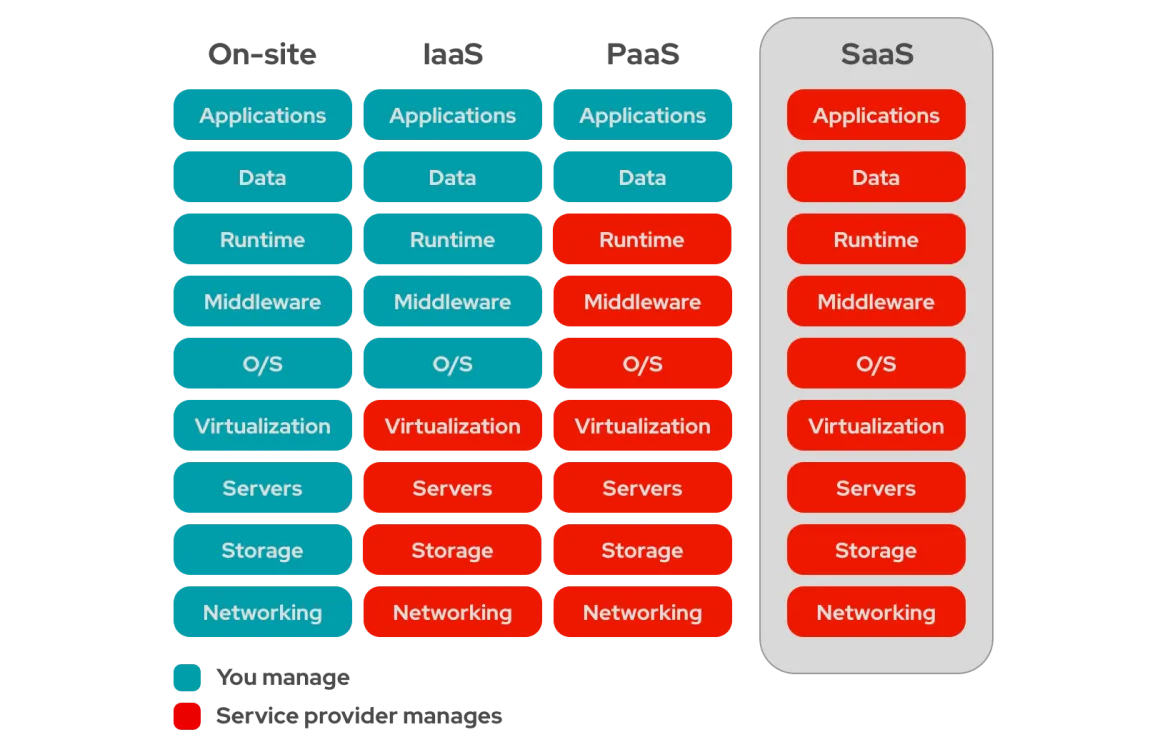Overview
Software-as-a-service (SaaS) is a form of cloud computing that delivers a cloud application—and all its underlying IT infrastructure and platforms—to end users through an internet browser. It can be an ideal solution for large enterprises, small businesses or individuals that:
- Do not want the responsibility of buying or maintaining infrastructure, platforms, and on-premises software.
- Prefers simpler cost management through operational expenses (OPEX), rather than capital expense investments (CAPEX).
- Have challenges that require minimal customization to solve.
- Favor software subscription models.
How does SaaS work?
SaaS reduces users’ upfront costs by eliminating the need to permanently purchase software or invest in a robust on-premise IT infrastructure—as is the case with traditional software. SaaS customers should invest in fast network hardware, however,since service performance is determined by internet connection speeds.
Examples of SaaS include application service providers (ASPs) like Google Docs and Microsoft Office 365, as well as enterprise services that deliver human resource software, e-commerce systems, customer relationship management tools, and integrated development environments (IDEs).
Software vendors typically choose 1—or both—of 2 common deployment models:
- In their own data center, or
- Through a public cloud service provider like AWS, Azure, or IBM Cloud, that manages the cloud environment on which the SaaS solution is hosted.
SaaS applications take advantage of multitenant architecture to isolate customer data. Software upgrades, bug fixes, and other general app maintenance are taken care of by the SaaS provider, while users interact with the software through a web browser. SaaS solutions are generally fully functional, but sometimes incorporate custom integration via application programming interfaces (APIs)—like REST or SOAP—to connect to other functions.
The nature of SaaS makes it easier for providers to roll out new features to their customers. Most SaaS applications are preconfigured plug-and-play products where the SaaS provider manages everything behind the app, including:
- Hardware components, like networking, storage, and datacenter servers
- Platforms, like virtualization, the operating system, and middleware
- Software requirements, like runtimes, data, and the app itself
Red Hat resources
The SaaS model
SaaS apps largely rely on subscription models for provisioning software licenses. Unlike a perpetual license, this software delivery model ties each account to a subscription that grants SaaS access for a period of time—usually on an annual or monthly basis. That subscription fee generally grants access to product documentation and ongoing support governed by a service level agreement (SLA), but some SaaS providers charge additional support fees to make custom code changes at the source code level.
PaaS vs IaaS vs SaaS
The term as-a-Service generally refers to a solution that is managed by someone else so you can focus on what’s important, like iterative improvements of custom apps. In addition to SaaS, other major as-a-Service options can include Infrastructure-as-a-Service (IaaS) and Platform-as-a-Service (PaaS).

IaaS means a provider manages the infrastructure for you—the actual servers, network, virtualization, and storage—via a cloud. The user has access to the infrastructure through an API or dashboard, and the infrastructure is rented. Users manage things like the operating system, apps, and middleware while the provider provides the hardware, networking, hard drives, storage, and servers—and the provider is responsible for taking care of outages, repairs, and hardware issues.
PaaS provides hardware and an application-software platform to users from an outside service provider. Since users handle the actual apps and data themselves, PaaS is an ideal solution for developers and programmers. PaaS gives users a platform on which to develop, run, and manage their own apps without having to build and maintain the infrastructure or environment that apps need to run.
Examples of SaaS vendors
Software vendors provide SaaS-style software applications to meet any number of business needs from basic business applications to complex enterprise resource planning (ERP) suites. Some SaaS companies and products include:
- SAP’s enterprise resource planning (ERP) software
- Paychex's human resource software
- CA Technology's enterprise software
- Atos messaging SaaS solution
- Salesforce's customer relationship management (CRM) software
- Slack’s messaging service
- Microsoft Office 365
- Dropbox’s file storage service
Build your SaaS with Red Hat
Become a SaaS vendor by participating in Red Hat SaaS Foundations-a program that helps Red Hat Partners build SaaS solutions on Red Hat platforms that can be deployed across all kinds of hybrid environments. Partners involved in this program can build applications more easily, go to market faster, and appeal to a broader range of potential customers.
Or, become a SaaS user through Red Hat Cloud Services, which includes hosted and managed platforms, applications, and data services that streamline the hybrid cloud experience, reducing the operational cost and complexity of delivering cloud-native applications.
Best of all, every subscription includes support. That’s advice and guidance to help you deploy, configure, and manage whatever as-a-Service Red Hat offering you use.
The official Red Hat blog
Get the latest information about our ecosystem of customers, partners, and communities.
